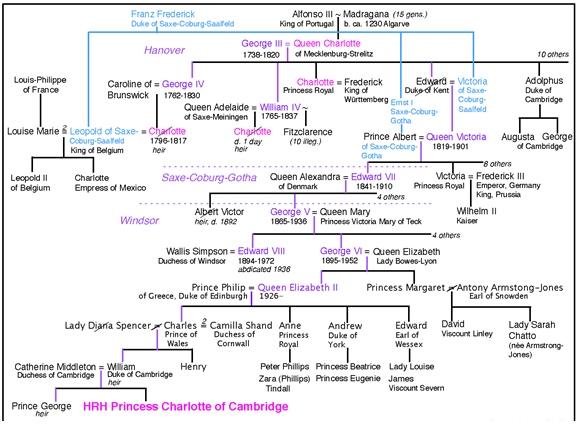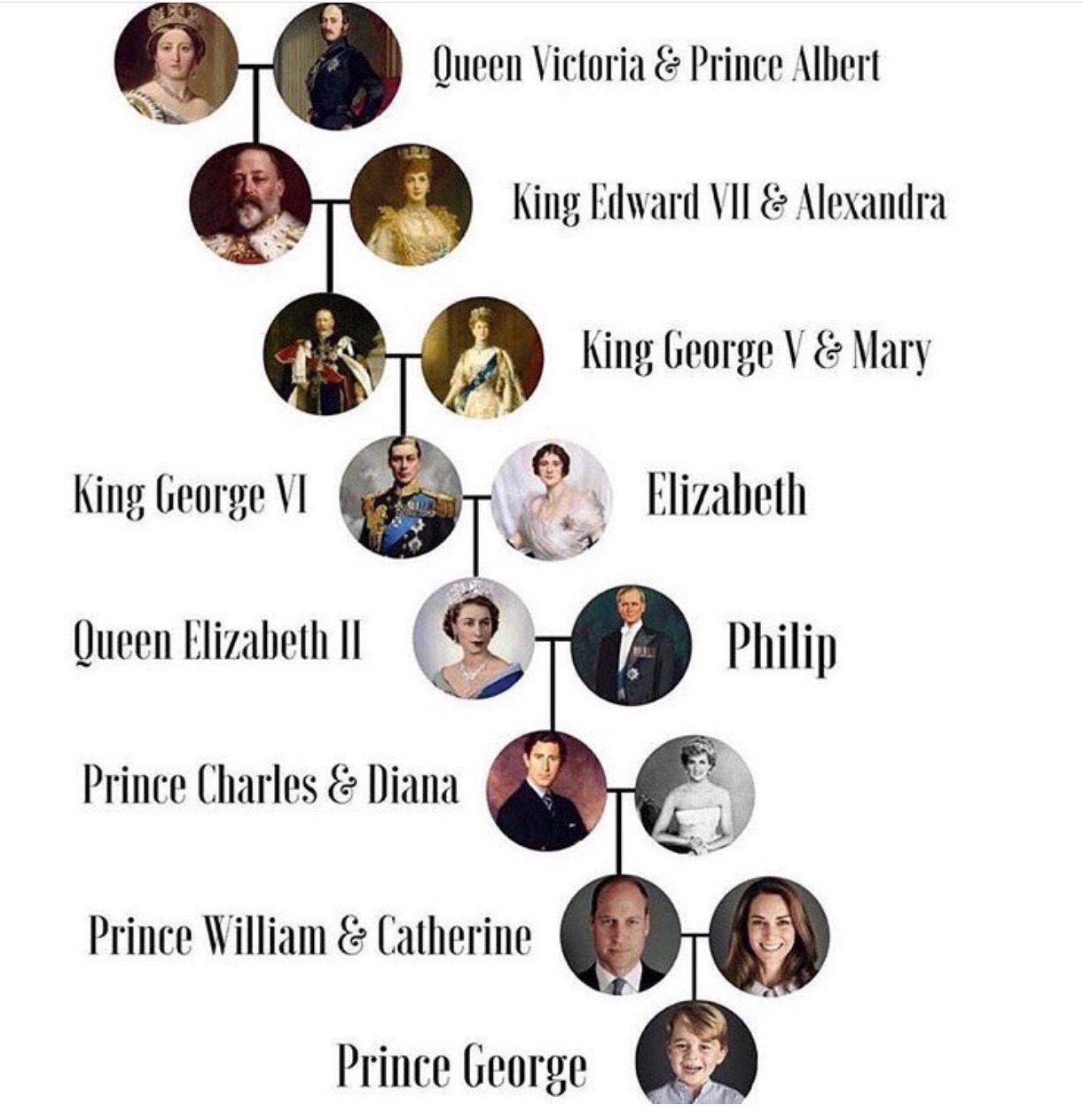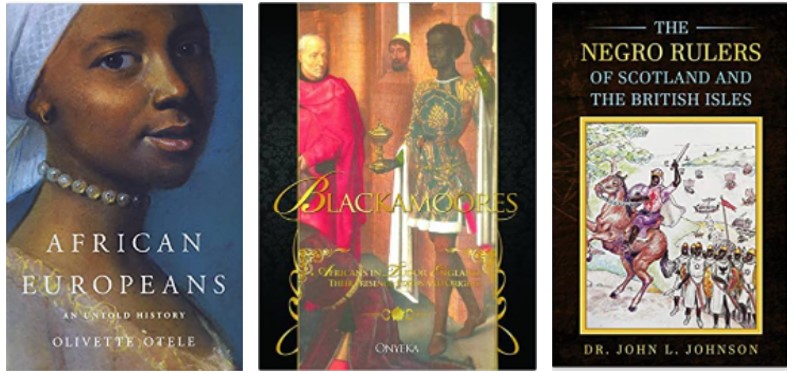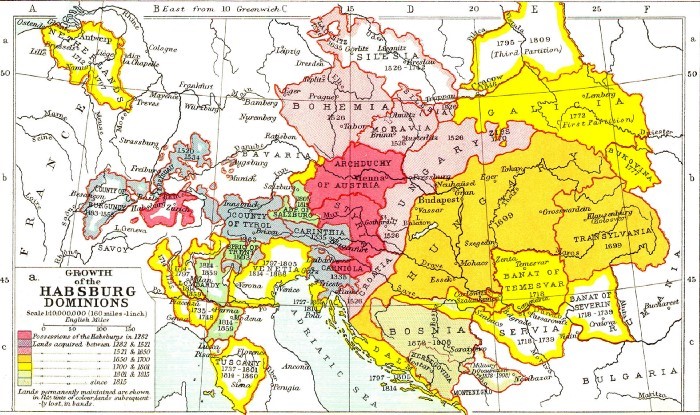 By Neenah Payne
By Neenah Payne
‘Invisible Queen:’ New Book Examines Britain’s Hidden Black Royalty reminds us that Prince Harry’s marriage to Meghan Markle in 2018 was controversial in Britain because her mother is Black.
However, Harry is himself of mixed blood! He is a descendant of Queen Victoria, granddaughter of Queen Sophia Charlotte, a mixed race Queen of England. Queen Charlotte was the wife of King George III who ruled Britain at the time of the American Revolution. See the family tree from Queen Victoria.
The video explains:
“The biggest engagement of the year is Britain’s Prince Harry and American actress Meghan Markle.… Meghan’s bi-racial makeup is causing some people’s blood to boil, but the truth is that the monarch’s bloodline has been mixed for centuries. Author Stephanie Myers recently published a book called “Invisible Queen, Mixed Ancestry Revealed” which details the life of the first Black British royal Sophia Charlotte, Queen of England.”
Invisible Queen: Mixed Ancestry Revealed
“Did you know that the Queen of England of 57 years had a mixed-race heritage with Moorish/African blood? Were you aware that Queen Sophia Charlotte was an abolitionist, a mother of 15 children, a botanist, and the one who discovered Mozart? She also worked with abolitionists to end slavery in England and tried ending it in the American colonies.
‘Invisible Queen’ tells the story of Charlotte Sophia, a smart mixed race German girl who was recruited to marry George III, King of England. Queen Charlotte reigned as Queen of England and Ireland for 57 years. She was an educated woman in the 1700’s, entertained US Presidents John Adams and Thomas Jefferson; was a dedicated aide to orphaned girls and much more.”
“Charlotte of Mecklenburg-Strelitz (Sophia Charlotte; 19 May 1744 – 17 November 1818) was Queen of Great Britain and Queen of Ireland as the wife of King George III from their marriage on 8 September 1761 until the union of the two kingdoms on 1 January 1801, after which she was Queen of the United Kingdom of Great Britain and Ireland until her death in 1818. As George’s wife, she was also Electress of Hanover until becoming Queen of Hanover on 12 October 1814, when the electorate became a kingdom.
Charlotte was born into the royal family of Mecklenburg-Strelitz, a duchy in northern Germany. In 1760, the young and unmarried George III inherited the British throne. As Charlotte was a minor German princess with no interest in politics, George considered her a suitable consort, and they married in 1761. The marriage lasted 57 years and produced 15 children, 13 of whom survived to adulthood. They included two future British monarchs, George IV and William IV; as well as Charlotte, Princess Royal, who became Queen of Württemberg; Prince Edward, the father of Queen Victoria; Prince Adolphus, grandfather of the British queen consort Mary of Teck; and Prince Ernest Augustus, who became King of Hanover.
Charlotte was a patron of the arts and an amateur botanist who helped expand Kew Gardens. She introduced the Christmas tree to Britain, after decorating one for a Christmas party for children from Windsor in 1800….She maintained a close relationship with Queen Marie Antoinette of France, and the French Revolution likely enhanced the emotional strain felt by Charlotte.
Her eldest son, George, was appointed as Prince Regent in 1811 due to the increasing severity of the King’s illness. Charlotte died in November 1818 with her son George at her side. Charlotte’s husband, who was likely unaware of her death, died a little over a year later.”
Meghan Markle, Queen Charlotte and the wedding of Britain’s first mixed-race royal
 Queen Charlotte, left, and Meghan Markle at her wedding to Prince Harry.
Queen Charlotte, left, and Meghan Markle at her wedding to Prince Harry.
(Print Collector/Getty Images; Neil Hall/EPA-EFE/Shutterstock)
“Only six hours before their royal wedding, King George III met Princess Sophia Charlotte of Mecklenburg-Strelitz for the first time….the German princess had finally arrived from the German coast in London on Sept. 8, 1761, where George had been impatiently awaiting his chosen bride. ‘In half an hour, one heard of nothing but proclamations of her beauty: everybody was content, everybody pleased.’ Walpole wrote. ‘She looks very sensible, cheerful, and is remarkably genteel.’
On Saturday, 257 years later, Britain’s Prince Harry married American actress Meghan Markle, whose mother is black and whose father is white. She’s been hailed as Britain’s first black royal.
But some historians who have researched this question say Charlotte was of African descent and was Britain’s first black royal. Historian Mario De Valdes y Cocom argues that Charlotte was directly descended from a black branch of the Portuguese royal family: Alfonso III and his concubine, Ouruana, a black Moor.
In the 13th century, ‘Alfonso III of Portugal conquered a little town named Faro from the Moors,’ Valdes, a researcher on the 1996 Frontline PBS documentary ‘Secret Daughter, said in an interview with The Washington Post. ‘He demanded [the governor’s] daughter as a paramour. He had three children with her.’ According to Valdes, one of their sons, Martin Alfonso, married into the noble de Sousa family, which also had black ancestry. And, thus, Charlotte had African blood from both families. Valdes, who grew up in Belize, began researching Charlotte’s African ancestry in 1967, after he moved to Boston.
After George ascended the throne in 1760, according to Buckingham Palace, he set upon a search for a bride. In July 1761, he announced to his council his intention to wed Charlotte.
 King George III and Queen Charlotte surrounded by some of their 15 children in 1787. Engraving by P Roberts after a painting by T Stothard. (Hulton Archive/Getty Images)
King George III and Queen Charlotte surrounded by some of their 15 children in 1787. Engraving by P Roberts after a painting by T Stothard. (Hulton Archive/Getty Images)
Valdes argues that several royal portraits painted Charlotte with the features of a black queen….In 1999, the London Sunday Times published an article with the headline: ‘REVEALED: THE QUEEN’S BLACK ANCESTORS.’ ‘The connection had been rumored but never proved,’ the Times wrote. ‘The royal family has hidden credentials that make its members appropriate leaders of Britain’s multicultural society. It has black and mixed-raced royal ancestors who have never been publicly acknowledged. An American genealogist has established that Queen Charlotte, the wife of George III, was directly descended from the illegitimate son of an African mistress in the Portuguese royal house.’
After the Times story, the Boston Globe hailed Valdes’s research as groundbreaking. Charlotte passed on her mixed-race heritage to her granddaughter, Queen Victoria, and to Britain’s present-day monarch, Queen Elizabeth II.
Some scholars in England dismissed the evidence as weak — and beside the point. ‘It really is so remote,’ the David Williamson, former co-editor of Debrett’s Peerage, the guide to Britain’s barons, dukes and duchesses, marquises and other titled people, told the Globe. ‘In any case, all European royal families somewhere are linked to the kings of Castile. There is a lot of Moorish blood in the Portuguese royal family and it has diffused over the rest of Europe. The question is, who cares?’
A Buckingham Palace spokesman did not deny Queen Charlotte’s African ancestry. Spokesman David Buck told the Globe: ‘This has been rumored for years and years. It is a matter of history, and frankly, we’ve got far more important things to talk about.” Valdes told The Post that in the current racial climate, Charlotte’s genealogy is important to history. Charlottesville, where white supremacists held a Unite the Right rally that turned violent, “is named after this queen. Her ancestry is very relevant.’
Charlotte, who knew no English upon her arrival, conversed in French and German with the king.
‘Less than a year after marriage, on 12 August 1762,’ according to Buckingham Palace, ‘The Queen gave birth to her first child, The Prince of Wales, who would later become King George IV. In the course of their marriage, the couple became parents of 15 children.’”
Europe’s Real History
African Europeans: An Untold History
“Conventional wisdom holds that Africans are only a recent presence in Europe. But in African Europeans, renowned historian Olivette Otele uncovers a long history of Europeans of African descent. From the third century, when the Egyptian Saint Maurice became the leader of a Roman legion, all the way up to the present, Otele explores encounters between those defined as ‘Africans” and those called “Europeans.”
She gives equal attention to the most prominent figures—like Alessandro de Medici, the first duke of Florence thought to have been born to a free African woman in a Roman village—and the untold stories—like the lives of dual-heritage families in Europe’s coastal trading towns. African Europeans is a landmark celebration of this integral, vibrantly complex slice of European history, and will redefine the field for years to come.”
The Negro Rulers of Scotland and the British Isles
“Dr. Johnson’s work has become vital for readers who seek an understanding of the origin of man, and Africa’s contribution to the Bible and Natural History. The author makes emphasis that during the great African migration, the concept of the wheel, mathematics, the alphabet, reading, writing, philosophy, science, astrology , astronomy, Fine Arts, family hierarchy, bureaucracy (government), king, queen, dynastic rule, huge universities, great cities and churches, were rudiments brought out of Africa and spread throughout the world; a marvelous accomplishment that led to the Ultra- structure of Western Civilization. This text highlights the earliest African rulers of Scotland, Southern Ireland and United Kingdom; a chronicle that focuses upon the Alpin Dynasty from Kenneth MacAlpin and his great-great-grandson Kenneth Dubh (Dub) or Kenneth the Niger (Black, Duff or Duffy), whose descendants of different appearances continued to rule Scotland, England, Ireland and other nations of Europe, even until this day.”
Blackamoores: Africans in Tudor England, Their Presence, Status and Origins
“Do we imagine English history as a book with white pages and no black letters in? We sometimes think of Tudor England in terms of gaudy costumes, the court of Henry VIII and Elizabeth I and perhaps Shakespearian romance. Onyeka’s book challenges our perceptions. Onyeka’s book is about the presence, status and origins of Africans in Tudor England… However, this book will show that some Africans in England had important occupations in Tudor society, and were employed by powerful people because of the skills they possessed.”
Black Tudors: The Untold Stories
Dr. Miranda Kaufmann gave the video presentation Black Tudors: Three Untold Stories. Dr. Kaufmann is the author of Black Tudors: The Untold Story. She is a Senior Research Fellow at the University of London’s Institute of Commonwealth Studies. Her book was shortlisted for the Wolfson History Prize 2018. She has appeared on Sky News, the BBC and Al Jazeera, and she has written for The Times, Guardian, and BBC History Magazine.
Dr. Kaufmann completed her doctoral thesis on “Africans in Britain, 1500-1640” in 2011. As a freelance historian and journalist, she has worked for The Sunday Times, the BBC, the National Trust, English Heritage, the Oxford Companion series, Quercus publishing. She is a popular speaker at conferences, seminars, and schools and has published articles in academic journals including the Times Literary Supplement, The Times, The Guardian, History Today, BBC History Magazine and Periscope Post. She has been interviewed by the BBC, Sky News, Al Jazeera USA, and the Observer.
Amazon Description
“The untold stories of the Black Tudors, dazzlingly brought to life by Kaufmann, will transform how we see this most intriguing period of history. Dr. Kaufmann begins her video presentation with Alessandro de Medici, the first Black head of state in modern western history. Alessandro de’ Medici was pivotal to the Grand Ducal and the most politically powerful period of Medici history. The de’ Medici who played an important role in European history and culture were one of the most powerful and influential dynasties in Europe. Alessandro de Medici is the scion from whom some of Europe’s most titled families descended, including two branches of the Hapsburgs.”
The Black Prince of Florence: The Spectacular Life and Treacherous World of Alessandro de’ Medici
PBS: Alessandro de Medici
“Despite the many portraits of this 16th century Italian Renaissance figure, his African heritage is rarely, if ever, mentioned.[Editor’s Note: For more on this omission as it has occurred in the art world, read this January 2005 update.] Alessandro wielded great power as the first duke of Florence. He was the patron of some of the leading artists of the era and is one of the two Medici princes whose remains are buried in the famous tomb by Michaelangelo. The ethnic makeup of this Medici Prince makes him the first black head of state in the modern western world.
Alessandro was born in 1510 to a black serving woman in the Medici household who, after her subsequent marriage to a muleteer, is simply referred to in existing documents as Simonetta da Collavechio. Historians today are convinced that Alessandro was fathered by the seventeen year old Cardinal Giulio de Medici who later became Pope Clement VII. Cardinal Giulio was the nephew of Lorenzo the Magnificent.
On being elected Pope in 1523, Cardinal Giulio…appointed a regent for his thirteen-year-old son Alessandro who had just been created Duke of Penna. Republicanism had grown in Florence under the regent and when Emperor Charles V sacked Rome in 1527. When peace was finally made two years later between the Papal and the Imperial factions, Charles V agreed to militarily restore Florence to the Medici. Alessandro was finally brought back as the Emperor’s designated head of state.
In 1532, the new Florentine constitution declared Alessandro hereditary Duke and perpetual gonfalonier of the republic. Though his common sense and his feeling for justice won his subjects’ affection, those in sympathy with the exiled opposition hated Alessandro. With the death of his father, the Pope, in 1534, the exiles attempted to oust the Duke Alessandro from Florence. But the Emperor decided to uphold Alessandro and in an obvious show of support, gave Alessandro his own illegitimate daughter, Margaret of Austria, as wife.
Despite the security this kind of support should have given him, Alessandro was finally assassinated a few months after his wedding by Lorenzaccio de Medici, a distant cousin. The greater majority of the noble houses of Italy can today trace their ancestry back to Alessandro de Medici. And, as shown in the two lines of descent to the Hapsburgs drawn up below, so can a number of other princely families of Europe.”
Wikipedia:
“Alessandro de’ Medici (22 July 1510 – 6 January 1537), nicknamed ‘il Moro’ (‘the Moor‘) due to his dark complexion, Duke of Penne and the first Duke of the Florentine Republic (from 1532), was ruler of Florence from 1530 to his death in 1537. The first Medici to rule Florence as a hereditary monarch, Alessandro was also the last Medici from the senior line of the family to lead the city.”
Alessandro De’ Medici: The Black Italian Head Of State
Alessandro de’ Medici Duke of Florence (Black Italian) “Alessandro the Moor” aka “Il Moro”
Neenah Payne writes for Activist Post and Natural Blaze
Become a Patron!
Or support us at SubscribeStar
Donate cryptocurrency HERE
Subscribe to Activist Post for truth, peace, and freedom news. Follow us on SoMee, Telegram, HIVE, Flote, Minds, MeWe, Twitter, Gab, What Really Happened and GETTR.
Provide, Protect and Profit from what’s coming! Get a free issue of Counter Markets today.





